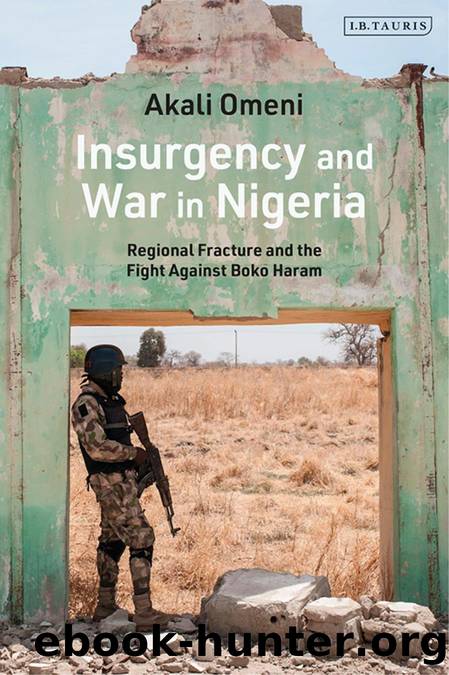Insurgency and War in Nigeria by Akali Omeni

Author:Akali Omeni
Language: eng
Format: epub
ISBN: 9781788317252
Publisher: Bloomsbury Publishing
Published: 2019-11-25T00:00:00+00:00
Figure 7.2 Total Number of Deaths, Monthly, in Boko Haramâs Insurgency. Data Source: Nigeria Security Tracker4
Figure 7.3 Total Number of Deaths, Annually, in Boko Haramâs Insurgency. Data Source: Nigeria Security Tracker5
Also, even if successful decapitation can take credit for some of the reduction of violence, it is worth observing that, relative to the number of senior figures and commanders in Boko Haram,6 the incidence of HVT captures or killings has been extremely low in Nigeria. Moreover, most of the killings or arrests outlined above came during a particular period when Operations DEEP PUNCH and RAWAN KADA by the Nigerian Army and with the assistance of the Multinational Joint Task Force (MNJTF) troops, were active.7 Indeed, aside from such heavily manned operations tasked specifically with targeting and eliminating Boko Haramâs senior leadership and fighters, HVTs, more often than not, are both difficult to locate and difficult to kill or capture. All this points to a likelihood that Boko Haram could stay resilient for the foreseeable future. After all this is a group that significantly escalated its military ambitions, just little past a year since its ranks were first decimated and its spiritual leader killed, in July 2009.
Dismantling Boko Haramâs network via grassroots intelligence and Civil-Military Cooperation (CIMIC)
With the chances of constantly stumbling upon HVTs low, and the potential of actionable intelligence on such individuals not high enough, Boko Haramâs command and organizational structure, as a result, appears unlikely to collapse on the strength of decapitation strategies alone. Notwithstanding if these strategies have been moderately successful. At a time, therefore, Boko Haramâs terror network had to be pieced together differently and then dismantled bottom-up so to speak, using untraditional activities not typically associated with the Nigerian Army. It is worth looking at that time, at the methodology employed by the Nigerian military and security apparatus, and at the success of this methodology. This approach, after all, remains operational within the governmentâs COIN effort.
Critical to this bottom-up approach, circa 2012 when the military first began putting together Boko Haramâs organizational wire diagram was a military-led schema of a five-process plan, signed off by Defence Headquarters (DHQ) and supported by the Office of the National Security Adviser (ONSA). The schema is broken down as follows.
(1) Trust-building within vulnerable communities, as a prerequisite for actionable intelligence. Trust-building occurred via a range of processes. These included âuse of traditional leaders, community and religious leaders as well as patriotic legislators from Borno State to denounce Boko Haram in rallies and make regular broadcasts in local languages [including Kanuri, Hausa and, in some cases, Arabic]â (JTFC 2012). (2) A form of influence operations aimed at changing perceptions: negatively against Boko Haram and positively towards the Army and security services. Townhall meetings, outreaches and medical projects were the first steps. Then, over time, infrastructural initiatives became another plank of the civil-military cooperation (CIMIC) task here. One example was in the âexecution of quick impact projects by the relevant FG agencies to include medical facilities, boreholes, renovation of schools and construction of roadsâ (JTFC 2012).
Download
This site does not store any files on its server. We only index and link to content provided by other sites. Please contact the content providers to delete copyright contents if any and email us, we'll remove relevant links or contents immediately.
| Central Africa | East Africa |
| North Africa | Southern Africa |
| West Africa | Algeria |
| Egypt | Ethiopia |
| Kenya | Nigeria |
| South Africa | Sudan |
| Zimbabwe |
Goodbye Paradise(2971)
Men at Arms by Terry Pratchett(2408)
Tobruk by Peter Fitzsimons(2064)
Pirate Alley by Terry McKnight(1910)
Arabs by Eugene Rogan(1837)
Borders by unknow(1789)
Belonging by Unknown(1472)
The Biafra Story by Frederick Forsyth(1325)
It's Our Turn to Eat by Michela Wrong(1305)
Botswana--Culture Smart! by Michael Main(1238)
A Winter in Arabia by Freya Stark(1225)
Gandhi by Ramachandra Guha(1196)
Coffee: From Bean to Barista by Robert W. Thurston(1183)
Livingstone by Tim Jeal(1152)
The Falls by Unknown(1142)
The Source by James A. Michener(1135)
The Shield and The Sword by Ernle Bradford(1101)
Egyptian Mythology A Fascinating Guide to Understanding the Gods, Goddesses, Monsters, and Mortals (Greek Mythology - Norse Mythology - Egyptian Mythology) by Matt Clayton(1088)
Africa: Altered States, Ordinary Miracles by Richard Dowden(1078)
